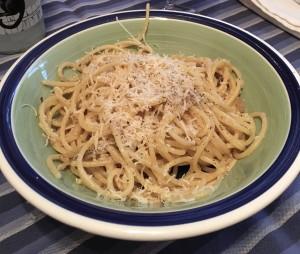Posted by Candice on Monday, May 23, 2016
I've recently gotten into somewhat of a rut with cooking--but it's a delicious, self-created rut. I am trying out different recipes for an Italian dish called cacio e pepe, which translates into 'cheese and pepper.' Simple, right? Yes, and no. Though recipes vary, the ingredients are generally the same: water, pasta, Pecorino Romano cheese, and pepper. You boil the pasta, grate the cheese, grind some pepper, then combine it all into a pan with a little bit of the pasta water. You end up with a well-coated plate of noodles. The not-so-simple part? First, deciding which recipe to use. I found at least five different ones in various cookbooks at the Library, all from well-known and respected chefs, several of them Italian, each one apparently saying that their recipe is the one to use. Some use the basic ingredients listed above, some add oil and/or butter. Some say that you should only use pecorino, while others also use Parmigiano-Reggiano or Cacio de Roma--all seem to use slightly different amounts. Some toss the pasta and cheese with a little oil or butter. Some sauté the pepper in some oil. Others toast the peppercorns in a pan before grinding. There is a lot of slight variation.
No problem, really, right? They're probably all good, so just pick one and go with it. Then you get to the other tricky part, which is really the only thing you 'do' besides prep and boiling--the mixing. When it goes well, you get a nice sauce. When it doesn't go well--and out of the four times I've made this, it hasn't gone well twice--you get the dreaded clumpy cheese. The recipes also vary quite a bit here, with different ones saying what to mix the ingredients in (warm dish, warm pan, cold dish), when to add cooking water and how much, and how to add the cheese and how to toss the pasta with it. Seems trivial, until you try one way and your cheese turns into small bits of pepper-flaked goop. Luckily, it still tastes very good.
I made cacio e pepe a couple nights ago, and I think it was my best one yet. I used a recipe from Lidia Bastianich. It's one of the simplest ones I've come across, so I wonder if I just got lucky. If you'd like to try your hand at mastering this deceptively simple dish, the Library has a wealth of Italian cookbooks for you to peruse to find a recipe. Let me know if you find a good one. Please.
Buon appetito!



This tightly-paced narrative follows several characters who all, ultimately, offer reflection upon some very important themes and ideas: love, trauma, the importance of stories, the danger of perceptions (our own, those placed on others), belonging, and safety...just to name a few. The book starts out simply enough, but really picks up pace and intertwines with the different characters so deftly that the reader can really get swept along. The storytelling is energetic here, and the language feels snappy and graceful at the same time. Fresh, timely, important, enjoyable. -Candice